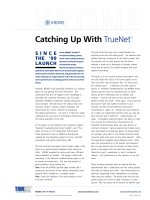Tài liệu Praise for Twitter API: Up and Runnin pptx
Bạn đang xem bản rút gọn của tài liệu. Xem và tải ngay bản đầy đủ của tài liệu tại đây (2.92 MB, 416 trang )
Praise for Twitter API: Up and Running
“Twitter API: Up and Running is a friendly, accessible introduction to the Twitter API. Even
beginning web developers can have a working Twitter project before they know it. Sit
down with this book for a weekend and you’re on your way to Twitter API mastery.”
— Alex Payne, Twitter API lead
“This book rocks! I would have loved to have had this kind of support when I initially
created TwitDir.”
— Laurent Pantanacce, creator of TwitDir
“Twitter API: Up and Running is a very comprehensive and useful resource—any developer
will feel the urge to code a Twitter-related application right after finishing the book!”
— The Lollicode team, creators of Twitscoop
“A truly comprehensive resource for anyone who wants to get started with developing
applications around the Twitter platform.”
— David Troy, developer of Twittervision
“An exceptionally detailed look at Twitter from the developer’s perspective, including
useful and functional sample code!”
— Damon Cortesi, creator of TweetStats, TweepSearch, and TweetSum
“This book is more than just a great technical resource for the Twitter API. It also provides
a ton of insight into the Twitter culture and the current landscape of apps. It’s perfect for
anyone looking to start building web applications that integrate with Twitter.”
— Matt Gillooly, lead developer of Twalala
“A wonderful account of the rich ecosystem surrounding Twitter’s API. This book gives
you the insight and techniques needed to craft your own tools for this rapidly expanding
social network.”
— Craig Hockenberry, developer of Twitterrific
twitter_praise_page Page i Thursday, March 12, 2009 12:35 PM
twitter_praise_page Page ii Thursday, March 12, 2009 12:35 PM
Twitter API: Up and Running
Twitter API: Up and Running
Kevin Makice
Beijing
•
Cambridge
•
Farnham
•
Köln
•
Sebastopol
•
Taipei
•
Tokyo
Twitter API: Up and Running
by Kevin Makice
Copyright © 2009 Kevin Makice. All rights reserved.
Printed in the United States of America.
Published by O’Reilly Media, Inc., 1005 Gravenstein Highway North, Sebastopol, CA 95472.
O’Reilly books may be purchased for educational, business, or sales promotional use. Online editions
are also available for most titles (). For more information, contact our corporate/
institutional sales department: 800-998-9938 or
Editor: Laurel R.T. Ruma
Production Editor: Sarah Schneider
Copyeditor: Rachel Head
Proofreader: Sarah Schneider
Indexer: Fred Brown
Cover Designer: Karen Montgomery
Interior Designer: David Futato
Illustrator: Robert Romano
Printing History:
March 2009: First Edition.
O’Reilly and the O’Reilly logo are registered trademarks of O’Reilly Media, Inc. Twitter API: Up and
Running
, the image of a white-breasted nuthatch, and related trade dress are trademarks of O’Reilly
Media, Inc.
Many of the designations used by manufacturers and sellers to distinguish their products are claimed as
trademarks. Where those designations appear in this book, and O’Reilly Media, Inc. was aware of a
trademark claim, the designations have been printed in caps or initial caps.
While every precaution has been taken in the preparation of this book, the publisher and author assume
no responsibility for errors or omissions, or for damages resulting from the use of the information con-
tained herein.
TM
This book uses RepKover™, a durable and flexible lay-flat binding.
ISBN: 978-0-596-15461-5
[M]
1236973332
Table of Contents
Preface . . . . . . . . . . . . . . . . . . . . . . . . . . . . . . . . . . . . . . . . . . . . . . . . . . . . . . . . . . . . . . . . . . . . xiii
1. Hello Twitter . . . . . . . . . . . . . . . . . . . . . . . . . . . . . . . . . . . . . . . . . . . . . . . . . . . . . . . . . . . 1
What Are You Doing? 2
Rules of Engagement 4
Opportunistic Interruptions 6
Twitter Is Like a Side-by-Side Conversation 8
History of Twitter 9
A Brief History of Microblogging 10
Believe It or Not: Twitter Was Inspired by Bike Couriers 12
Millions and Millions Served 14
The Rise of the Fail Whale 16
Who Wants to Be a Millionaire? Gauging Twitter’s Profitability 20
Developers Are Users, Too 23
Creative Uses of Twitter 25
Twitter Utilitarianism 26
Twitter for News 27
Twitter for Science 28
Twitter for God 29
Twitter for Emergencies 30
Twitter for Marketing 31
Twitter for Social Change 32
Twitter for Money 34
Twitter for Games 34
Twitter for Anthropomorphism 35
Twitter for Help 36
Twitter for Creativity 37
Twitter for Education 38
Twitter for Entertainment 38
Twitter for Sports 39
Twitter for Evil 40
Twitter As a Shared Event 41
vii
Twitter for Everyone 42
A Changing Culture 43
2. Twitter Applications . . . . . . . . . . . . . . . . . . . . . . . . . . . . . . . . . . . . . . . . . . . . . . . . . . . . 45
Twitter’s Open API 46
Finding Inspiration 47
Tools for Publishing 48
Twitterfeed 48
SnapTweet 49
SecretTweet 50
Tools for the Information Stream 51
Twittervision 52
Twitter Matrix 53
Twalala 54
Tools of Appropriation 55
Track This 55
LiveTwitting 56
FoodFeed 57
Tools for Search 58
TwitDir 59
Green Tweets 60
TweetBeep 61
Tweet Scan 62
Favrd 63
Tools of Aggregation 64
Twappi 64
Twitscoop 65
Twist 66
Tools for Statistics 67
What’s Your Tweet Worth? 67
TweetStats 68
Follow Cost 70
Twitter Grader 71
Twitterank 72
Tools for the Follow Network 74
Does Follow 74
Qwitter 75
Friend or Follow 76
Mr. Tweet 77
Omnee 78
Twitree 79
And Many More 80
viii | Table of Contents
3. Web Programming Basics . . . . . . . . . . . . . . . . . . . . . . . . . . . . . . . . . . . . . . . . . . . . . . . 83
XHTML 83
Web Pages 84
A Nod to Some Other XML Structures 89
CSS 90
Assigning Styles to Structure 92
Laying Out Your Web Page Content 93
Decorating the Web Page Content 94
Getting the Browser to Recognize Styles 95
PHP 96
How to Accept Candy from Strangers 97
Strings, Arrays, and Objects 98
Manipulating the Data You Collect 100
Knowing Your Environment 104
Controlling the Flow of Logic 106
File Management 109
Connecting to the Database 111
Building a Custom Function 113
SimpleXML 116
DOM 117
cURL 118
Debugging 120
MySQL 122
Creating a New Table 123
Retrieving Information from the Database 124
Changing Information in the Database 125
A Place to Call /home 126
Selecting a Host Server 126
Automation 128
Further Reading 130
4. Meet the Twitter API . . . . . . . . . . . . . . . . . . . . . . . . . . . . . . . . . . . . . . . . . . . . . . . . . . 133
Accessing the API 134
HTTP Requests 134
HTTP Status Codes 137
Format 139
Authentication 140
A Peak at OAuth 141
Parameters 143
Rate Limiting 147
Keeping Development Light 148
Play Along at Home 149
The API Methods 150
Table of Contents | ix
Publishing 151
The Information Stream 152
The Follow Network 157
Communication 165
Member Account 168
API Administration 174
Search 176
Other Data Options 181
Gone Phishing: A Word About Passwords 182
Is Twishing Worth the Effort? 184
OAuth Can Help 187
5. Meet the Output . . . . . . . . . . . . . . . . . . . . . . . . . . . . . . . . . . . . . . . . . . . . . . . . . . . . . . 191
User Objects 192
User Elements 195
Status Objects 198
Status Elements 200
Message Objects 202
Direct Message Elements 204
Search Objects 205
Feed Elements 206
Entry Elements 207
ID Objects 208
ID Elements 208
Response Objects 209
Response Elements 209
Hash Objects 209
Hash Elements 210
Errors 211
6. Application Setup . . . . . . . . . . . . . . . . . . . . . . . . . . . . . . . . . . . . . . . . . . . . . . . . . . . . . 213
Establishing Your Twitter Account 214
Registering a New Twitter Member Account 215
Configuring Your New Account 217
Creating Your Database 222
Making Sure There Is a There There 223
Giving the Database Some Structure 223
Included Functions 227
Creating Your Includes Directory 227
Environment Functions 229
API Configuration Functions 230
Database Functions 234
SQL Queries 235
x | Table of Contents
Data Parsing Functions 240
Password Management Functions 246
Data Validation Functions 249
Data Sorting Functions 252
Statistics Functions 253
Log Management Functions 254
Status Messages 255
HTML Template Functions 257
CSS 260
7. Sample Applications . . . . . . . . . . . . . . . . . . . . . . . . . . . . . . . . . . . . . . . . . . . . . . . . . . . 263
Meet the Sample Apps 263
Why Are You Asking for My Password? 265
Administration Tool 267
Take the App for a Spin 267
Check Under the Hood 268
Shifting Gears 275
Tweet Publisher 277
Take the App for a Spin 277
Check Under the Hood 278
Shifting Gears 282
Auto Tweet 282
Take the App for a Spin 283
Check Under the Hood 284
Shifting Gears 290
Tweet Broadcast 291
Take the App for a Spin 291
Check Under the Hood 293
Shifting Gears 299
Broadcast Feed 300
Take the App for a Spin 300
Check Under the Hood 300
Shifting Gears 304
Tweet Alert 305
Take the App for a Spin 305
Check Under the Hood 307
Shifting Gears 312
Network Viewer 313
Take the App for a Spin 313
Check Under the Hood 315
Shifting Gears 323
Best of Twitter API 324
Take the App for a Spin 325
Table of Contents | xi
Check Under the Hood 326
Shifting Gears 329
8. Automated Tasks . . . . . . . . . . . . . . . . . . . . . . . . . . . . . . . . . . . . . . . . . . . . . . . . . . . . . 331
RSS to Tweet 332
Check Under the Hood 333
Aggregate Broadcast 338
Check Under the Hood 339
Scan Tweets 342
Check Under the Hood 343
Queue Users 349
Check Under the Hood 350
Collect Favorites 352
Check Under the Hood 353
Appendix: Twitter API Reference . . . . . . . . . . . . . . . . . . . . . . . . . . . . . . . . . . . . . . . . . . . . . . 361
Index . . . . . . . . . . . . . . . . . . . . . . . . . . . . . . . . . . . . . . . . . . . . . . . . . . . . . . . . . . . . . . . . . . . . . 377
xii | Table of Contents
Preface
One reason Twitter resonates with me is its simplicity. I’ve blogged in some form or
another since 2000, when my first son was born. It takes a lot of time and thought to
compose even a few paragraphs of meaningful text for a blog. You can add pictures
and video, fiddle with the formatting, and reference many other sites with hyperlinks.
It is an incredibly useful practice, but rarely does blogging fit into one of those natural
moments between tasks. Twitter, on the other hand, won’t let you contribute more
than a few thoughts or a link or two with each post, and only then if it fits into the 140-
character limit. There is no formatting or multimedia embedding; it is just a simple act
of thinking, sharing, responding, or emoting.
Since Twitter’s award-winning appearance at the South By Southwest (SXSW) confer-
ence in 2007, many have called for it to improve on the simple things it does. Why
aren’t there groups? Can we make our posts longer? Will pictures show up in the time-
line? How can I manage my private messages to other users? Although Twitter has on
occasion responded to collective behavior or demand by implementing a new wrinkle
(as with @username replies), the service has largely remained as it began: simple.
It is a credit to Twitter that it has resisted such changes. Making the service less simple
would also make it less versatile. The void of unanswered user requests for functionality
is filled by an ecosystem of third-party developers. The incentive for the innovation and
resources these developers bring to the Twitter community would be critically lowered
if the main service tried to do too much. A simple Twitter is better not only for the users
trying to post their status updates, but also for the third-party applications trying to
find their niches.
The purpose of Twitter API: Up and Running is to provide an introduction to using the
Twitter API—the means to get at the rich Twitter data—to build web applications.
This book has three main parts: an overview of the Twitter ecosystem and culture;
background information on the languages and environment you need to create your
applications; and working code for a suite of sample applications meant to get you
started on your programming adventure. Novice readers should be able to gather
working knowledge from the PHP scripts used to create the sample applications and
see how the syntax works in context. Experienced readers will likely benefit from the
references for the API methods as well as discussions about the context into which your
applications will be placed.
xiii
As Twitter lowers barriers to publication through its simplicity, so this book will pro-
vide easy access to the skills and resources you’ll need to build web applications for its
API.
Who This Book Is For
The cultivation of open API development represents another level of evolution in In-
ternet participation. We aren’t just reading and writing content; we’re also cocreating
the interactions surrounding that content. Twitter, in particular, has a low barrier for
both. The most important property of the Twitter API is not found in the nuances of
its syntax, but rather in the imaginative and prolific cocreation it inspires.
This groundbreaking book is for Twitter fans who want to do more than just answer
the question, “What are you doing?” In this first book about working with the Twitter
API, new and casual programmers are provided with explanations of how each part of
the API functions and examples of how those parts can be assembled into web appli-
cations. We’ll also look closely at the culture of Twitter and how it has inspired pro-
grammers to build their own tools and games.
A prerequisite for this book is a basic understanding of how applications are built and
hosted on the Web. However, you don’t need to be a professional coder to launch a
Twitter web application successfully. The XHTML, CSS, PHP, and MySQL code nec-
essary to the construction of the example applications will be provided and explained,
as will some suggested criteria for securing a website. You should be able to pick up
this book, follow the sample code, and have at your disposal a working application to
use and modify.
The sample code can be downloaded from this book’s website (http://
www.oreilly.com/catalog/9780596154615/). It is open and available for
anyone to use.
Among the wide range of readers of this book will be IT professionals in small organ-
izations and Twitter members looking for a programming project. In the former sce-
nario, an IT professional may be looking at Twitter as a potential platform to integrate
existing services or products provided by his employer. He can use this book to survey
some web tools that might serve as a foundation for a larger web application. In this
context, it becomes a project companion with additional long-term value as a reference
and directory of sample applications.
In the latter scenario, an active member of the Twitter community may have grown
tired of waiting for someone else to provide missing functionality and be thinking about
adding it herself. She might read this book first to see what is out there, in case someone
has already built the desired tool, and then try to code the web application herself. She
may not consider herself a programmer, but she can build off of the sample code and
xiv | Preface
learn details by referencing the chapters on PHP and MySQL functions, selecting the
sample application closest to what she has in mind and then making changes to add
the desired behavior.
Twitter is a hot topic, but not much has been written about it yet. Therefore, the in-
formation this book contains on the history of the Twitter culture will also make it
attractive to nonprogrammers who want to understand the phenomenon, such as de-
cision makers for company development teams or active Internet users new to Twitter.
How This Book Is Organized
This book introduces the Twitter API in the context of a greater community culture,
offering a suite of sample applications to help illustrate some key programming con-
cepts. Here’s a synopsis of what you’ll find:
Chapter 1, Hello Twitter
Gives you a comprehensive overview of the Twitter culture, including the history
of microblogging, the Fail Whale, the company business model, the API developer
community, and creative uses of Twitter.
Chapter 2, Twitter Applications
Reviews more than two dozen existing third-party Twitter web applications you
can use as inspiration for your own creations. The applications are grouped into
seven tools categories—Publishing, Information Stream, Appropriation, Search,
Aggregation, Statistics, and Follow Network tools—and each app is profiled with
a screenshot and a description of what it does.
Chapter 3, Web Programming Basics
Provides a comprehensive starter kit for XHTML, CSS, PHP, and MySQL. This
chapter is meant to be a primer for new programmers and a convenient reference
for more experienced programmers. It also offers some advice on what to look for
when searching for a web host to care for your new application.
Chapter 4, Meet the Twitter API
Gives the details on how to make requests of the Twitter API. Included in the
general explanation are format differences, HTTP methods and error codes, au-
thentication, and rate limits. This chapter contains a directory of all of the param-
eters used by the API and a description of each of the 40 methods, grouped into
seven categories: Publishing, Information Stream, Follow Network, Communica-
tion, Member Account, API Administration, and Search. It also includes a discus-
sion about security issues involving Basic Auth and a brief description of how to
use cURL to test the API.
Chapter 5, Meet the Output
Takes a look at what comes out of the API as a response from Twitter. The various
types of XML objects you will encounter—user, status, message, search, ID,
Preface | xv
response, and hash—are detailed with example output, explanations of the inclu-
ded XML elements, and a list of methods that return that object.
Chapter 6, Application Setup
Discusses the things you need to do to get your web environment ready, including
creating a master Twitter account, making your MySQL database tables, creating
your stylesheet, and uploading custom functions to a directory outside the web
path. Each of the custom functions used in the sample applications is discussed in
detail, with a description of what it does and PHP code provided as examples.
Chapter 7, Sample Applications
Describes the web interfaces from the suite of sample applications. For each of the
seven applications, I’ll run you through how to use it and what it does, and then
we’ll look closely at the code. Included are suggestions for how to make this starter
code better.
Chapter 8, Automated Tasks
Describes the code for the programs from the suite of sample applications that run
in the background. It includes a brief explanation of what each of the five scripts
does and how the PHP code works.
Appendix
Provides a bare-bones look at the Twitter API, listing the method path, whether it
requires authentication, if it is charged against your rate limit, the HTTP method
type, and any required and optional parameters.
Conventions Used in This Book
The following typographical conventions are used in this book:
Italic
Used for emphasis, technical terms where they are defined, URLs, email addresses,
filenames, file extensions, and pathnames.
Constant width
Used for code samples, SQL statements, HTML and XML elements, methods,
functions, variables and attributes and their values, objects, and class names.
Constant width italic
Used for user-replaceable items in code.
Constant width bold
Used for emphasis in code samples.
This icon signifies a tip, suggestion, or general note.
xvi | Preface
This icon indicates a warning or caution.
Using Code Examples
You may use the code in this book in your programs and documentation. You do not
need to contact us for permission unless you’re reproducing a significant portion of the
code. For example, writing a program that uses several chunks of code from this book
does not require permission. Selling or distributing a CD-ROM of examples from this
book does require permission. Answering a question by citing this book and quoting
example code does not require permission. Incorporating a significant amount of ex-
ample code from this book into your product’s documentation does require permission.
We appreciate, but do not require, attribution. An attribution usually includes the title,
author, publisher, and ISBN. For example: “Twitter API: Up and Running, by Kevin
Makice. Copyright 2009 Kevin Makice, 978-0-596-15461-5.”
If you feel your use of code examples falls outside fair use or the permission given above,
feel free to contact us at
Safari® Books Online
When you see a Safari® Books Online icon on the cover of your favorite
technology book, that means the book is available online through the
O’Reilly Network Safari Bookshelf.
Safari offers a solution that’s better than e-books. It’s a virtual library that lets you easily
search thousands of top tech books, cut and paste code samples, download chapters,
and find quick answers when you need the most accurate, current information. Try it
for free at />We’d Like to Hear from You
Please address comments and questions concerning this book to the publisher:
O’Reilly Media, Inc.
1005 Gravenstein Highway North
Sebastopol, CA 95472
800-998-9938 (in the United States or Canada)
707-829-0515 (international or local)
707-829-0104 (fax)
Preface | xvii
We have a web page for this book, where we list errata, examples, and any additional
information. You can access this page at:
/>To comment or ask technical questions about this book, send email to:
For more information about our books, conferences, Resource Centers, and the
O’Reilly Network, see our website at:
Acknowledgments
It has always been a dream to write a book. While for a long time I thought it would
be about time travel or dragons, I’m delighted that my dream was fulfilled under the
banner of O’Reilly Media. For that, I have a number of people to thank.
This book is dedicated to my family—Amy (@amakice), Carter (@cmakice), Archie,
and the TBD baby we were creating during the nine months it took to write this tome—
who went out of their way to give me time and space to type, type, type. By now, with
me five years into an older-student Ph.D., they are used to helping me get my 3–5 hours
of sleep each night, while keeping me fed and entertained. However, writing a book on
top of graduate school is like adding a couple more dissertations to the workload. It
takes a village to write a tech book. As they supported me, my family received support
from Amy’s and my parents—Susan Clendening (@twobigdogs); Roger (@rjisb) and
Jean Isbister; Gary and Carol Clendening; Joy and Pete Kottra—and our friends. I am
particularly grateful for the supplemental financial support from that group and from
my long-time friend, Tim Roessler, who can now take this dedication as a direct request
to sign up for Twitter.
From the O’Reilly camp, Laurel Ruma (@laurelatoreilly) ran point on this project.
Despite my being intimidated by both the brand and the endeavor, she held my virtual
hand throughout the process and gently kept me on task. That this book arrived on
bookshelves near you is a credit to her stewardship that made this project such a won-
derful experience for me. I wouldn’t have met her at all if it weren’t for Jeffrey Bardzell
(@jeffreybardzell), my professor and friend, who referred me to his agent Carole Jelen
McClendon at Waterside Productions. Carole, now my agent, helped me pitch an idea
for a Twitter book to John Osborn (@johnatlarge) and Laurel. Nine months later I was
holding my first published book. From top to bottom, the O’Reilly Media organization
was amazing. Rachel Head, Sarah Schneider, Marlowe Shaeffer, and Rachel Monaghan
were also key to completing this project, and I thank them all for their professionalism
and patience.
xviii | Preface
I’d also like to thank the great early tech reviewers that O’Reilly assembled to help
improve the content in the book: Alex Payne (@al3x), Ed Finkler (@funkatron), Eric
Stern (@Firehed), Cameron Kaiser (@doctorlinguist), Bill Ryan (@wgryan), Lisa
Hoover (@lisah), Abraham Williams (@poseurtech), Dave Troy (@davetroy), Jeff
Clark (@jeffclark), Matt Gillooly (@mattgillooly), Damon Cortesi (@dacort), and the
Lollicode team. Ed was particularly helpful in answering follow-up questions after his
initial review, improving security in the sample code, and taking a second peek at ad-
ditional sections written into later drafts. I am also appreciative of the fact that Alex
was willing to spend so much time looking at my words when he was writing his own
O’Reilly book on Scala. This book is all the better for their participation.
My local Twitter community deserves props as well. I am in awe that a small university
city could muster over 650 early adopters of the service, many of whom were among
my peers at the Indiana University School of Informatics. Their use of Twitter is what
makes my timeline so valuable. In the process of testing the code for this book, I had
to rely on a number of people in my follow net to make sure I wasn’t inadvertently
blowing up oil rigs in the Gulf. Thanks to my early reality checkers: Michelle
(
@MzHartz), Allison (@allisoncooke), Joel (@rhythmofself), Jonathan (@Jonathan-
Branam), Noah (@noahwesley), Steve (@SoundSystemSDC), Daniel (@b00ger),
Chintan (@tankchintan), Mike (@dmikeallen), Jenny (@jbhertel), and several others.
The Twitter version of this would be: “@everyone thanks!”
Preface | xix
CHAPTER 1
Hello Twitter
kmakice For a thing to have meaning, it must have context.
I can remember what life was like without Twitter. The many interesting thoughts
popping out of my brain throughout the day had to fight for supremacy. Like an intel-
lectual Thunderdome, only one thought could emerge to become a blog. No one knew
when I was sleeping and when I was watching Battlestar Galactica on my TiVo. I had
no way of being alerted when someone local was heading to Chicago so that I could
express to that person my love of Edwardo’s stuffed pizzas as a passive hint to deliver.
Before Twitter, my connection with the other people in my academic program was
constrained by time and space. I could only inquire about their work or ask what they
were eating if we were in the same room with overlapping moments of free time. My
news about hurricanes and earthquakes was limited to what I could glean from
CNN.com and Weather Underground. There were no personal accounts of mass evac-
uations, nothing to tell me instantly where someone was when the ground started
shaking.
Mercifully, a solution emerged. Twitter—a channel for sharing individual status up-
dates with the world—has brought value to the mundane. We have evolved out of that
bygone era and into a world measured 140 characters at a time.
Kelly Abbott (@KellyAbbott) of Dandelife introduced me to Twitter through a little
Flash widget featured in the sidebar of his blog. It displayed a running list of short
journal entries about his life. I clicked and registered my own Twitter account (see
Figure 1-1) about a week before the service exploded onto the scene with an award-
winning presence at the South by Southwest (SXSW) conference
*
in March 2007.
*
South By Southwest is an annual conference held in Austin, Texas to showcase the latest in music, film, and
interactive media. It started in 1987 as a small music festival, and now draws over 11,000 people each year.
1
Figure 1-1. My first tweet
The estimated number of Twitter accounts surpassed 3 million during the summer of
2008, according to third-party tools. (Twitter does not provide official statistics on
membership.
†
) Compete reported an 812% increase in unique monthly visitors to the
Twitter website in 2008, jumping to almost 6 million in January 2009.
‡
Interest in the
channel comes not just from the producers and consumers of content, but also from
developers of desktop applications, information visualization systems, Internet mash-
ups, and completely new services not possible before Twitter existed. Tweets—the
name given to the brief status updates—are used for many purposes, from alerting local
communities about emergency situations to playing games. They can even facilitate the
sale of beer. Although Twitter is not without critics, it seems clear that microblogging
is here to stay.
You undoubtedly bought or borrowed this book because you are interested in pro-
gramming some system or widget using the Twitter application programming interface
(API). Doing that effectively requires more than just knowing what to code; it is also
important to know how your new amazing “thing” is going to fit into the culture Twitter
and its users have created. Don’t underestimate the importance of culture. For a thing
to be meaningful, it has to have context. In this chapter, we’ll look at the world into
which your application will be hatched.
What Are You Doing?
Ian Curry of Frog Design once likened twittering to bumping into someone in a hallway
and casually asking, “What’s up?” In a 2007 blog post, Curry noted:
It’s not so important what gets said as that it’s nice to stay in contact with people. These
light exchanges typify the kind of communication that arises among people who are
saturated with other forms of communication.
§
†
TwitDir () launched a member directory in the first half of 2007. Among other things,
this website tracked the number of unique member accounts encountered while monitoring the public
timeline.
‡
Compete’s SiteAnalytics reported 5,979,052 unique visitors to in January 2009, up from
655,067 in January 2008 ( />§
From the February 26, 2007 blog article, “Twitter: The missing messenger,” by Ian Curry of Frog Design
( />2 | Chapter 1: Hello Twitter
Leisa Reichelt of disambiguity called it “ambient intimacy,” the ability to keep in touch
with people in a way that time and space normally make impossible.
‖
For Wired mag-
azine writer Clive Thompson (@pomeranian99), it’s a “sixth sense,”
#
incredibly useful
in understanding when to interact with coworkers. Twitter has also been described as
a low-expectation IRC. Brett Weaver considers each tweet the atomic level of social
networking.
*
It is a phatic function of communication, keeping the lines of communi-
cation between you and someone else open and ready and letting you know when that
channel has closed. All of these terms suggest what experience has already taught mil-
lions of people: there is great value in small talk.
The main prompt for all this contact on Twitter is a simple question: “What are you
doing?” In practice, that question is usually interpreted as, “What interesting thought
do you want to share at this moment?” The variety of potential responses is what makes
Twitter such a valuable and versatile channel.
The throwaway answers include messages of context, invitation, social statements,
inquiries and answers, massively shared experiences, device state updates, news broad-
casts, and announcements. Twitter is used for many purposes, including:
• Sharing interesting web links
• Reporting local news you have witnessed
• Rebroadcasting fresh information you have received
• Philosophizing
• Making brief, directed commentaries to another person
• Emoting and venting
• Recording behavior, such as a change in location or eating habits
• Posing a question
• Rickrolling ( />• Crowdsourcing
• Organizing flash mobs and tweetups (in-person meetups with Twitter friends)
Small comments return big value when shared with the world. Not everyone will read
what you post, of course, but those who do get to sample a small bit of your life in a
way previously available only to those who happened to bump into you in a hallway
or on the street. In this sense, the primary value of Twitter can be found in the small,
informal contact it enables between its users.
‖
From the March 1, 2007 blog article, “Ambient intimacy,” by Leisa Reichelt of disambiguity (http://www
.disambiguity.com/ambient-intimacy).
#
Clive Thompson, “How Twitter Creates a Social Sixth Sense,” Wired 15:7 (June 26, 2007) (ed
.com/techbiz/media/magazine/15-07/st_thompson).
*
From the January 28, 2009 blog article, “4 Must have tools to automate Twitter,” by Brett Weaver, published
on Active Rain ( />What Are You Doing? | 3









